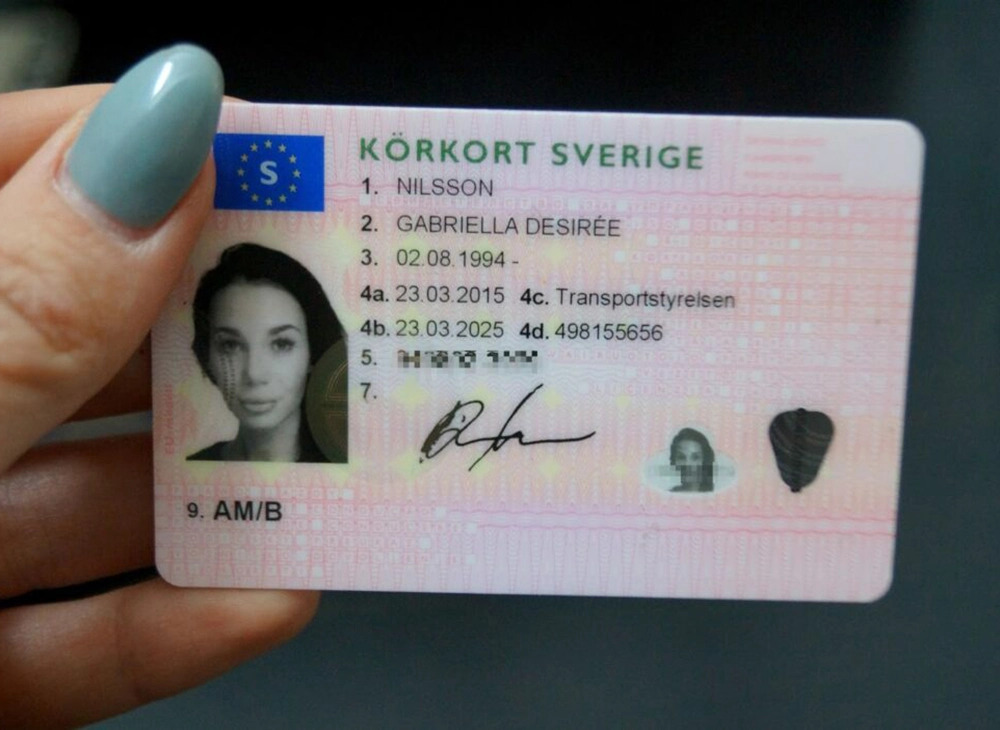10 Reasons You'll Need To Be Aware Of I Will Buy A Category B Driving …
페이지 정보

본문
I Will Buy a Category B Driving License
When it pertains to a career in industrial driving, there are many aspects that enter play. From the training and testing requirements to the readily available task opportunities and wage capacity, there is a lot to think about before making your choice.
 Among the most important aspects to think of is which CDL class you wish to acquire. This will determine your ability to drive lorries varying from guest vans to little HAZMAT trucks.
Among the most important aspects to think of is which CDL class you wish to acquire. This will determine your ability to drive lorries varying from guest vans to little HAZMAT trucks.
What is a commercial driver's license?
A business driver's license (CDL) is a kind of driving license needed for people who operate big or heavy vehicles for business functions. It is a class-based license that identifies the type of automobile a person can drive and also sets out requirements connecting to age, health, and security. There are 3 main categories of CDL: Class A, Class B, and Class C. These classes identify the types of truck and trailer combinations a driver can operate.
Normally speaking, an individual must have a class B or higher CDL to run a commercial truck and trailer combination with a gross car weight ranking of 26,000 pounds or more. The CDL might be endorsed with several recommendations, which are additional constraints that can even more limit the kind of trucking work a person can do. For example, an H recommendation allows motorists to carry harmful materials, and an N endorsement enables motorists to run cars that carry tanks. Other typical endorsements include a P, which enables drivers to run guest automobiles, and an S, which allows motorists to run school buses.
In addition, a person should have the ability to meet the Federal Motor transportstyrelsen beställa nytt skoterkort tappat körkort beställa nytt (Read the Full Piece of writing) Carrier Safety Administration's medical requirements in order to drive a commercial truck. These requirements normally involve a physical test and submitting to alcohol and drug screening. Additionally, in lots of states, an individual will require to pass a background check and send to a rap sheet search before they can obtain a CDL.
People who desire to become truck drivers typically have a tough time deciding which kind of CDL they need. There are a number of different kinds of CDLs, and each one has its own advantages and restrictions. For example, borttappat körkort beställa nytt (relevant site) a Class A CDL permits motorists to operate all type of tractor-trailer cars, and it can be used for interstate or intrastate commerce. However, a Class B CDL only covers particular tractor-trailer cars and needs the driver to adhere to stringent state and federal laws. In addition, any convictions on a CDL will be reported to the driver's home state and will be considered as part of their driving record.
What is a class B license?
The choice to obtain a Class B or Class A CDL is a crucial step for truck motorists on their career course. It will impact their income potential, the type of lorries they can drive, and the driving types they choose. It is also necessary to think about the long-lasting objectives of the driver, and how this option will fit with their lifestyle.
A class B license permits business drivers to run heavy single vehicles with a GVWR of 26,001 pounds or more, as well as little trailers that are connected to those cars. This category includes straight trucks, garbage and dump trucks, delivery van, and even seal mixers. In some states, a class B driver can likewise make CDL recommendations, which are extra approvals that enable them to operate specific lorries, such as hazmat.
In addition to having a legitimate driver's license, you will need to finish entry level training at a CDL school that is noted on the Federal Motor Carrier Training Provider Registry. You will need to undergo a medical assessment and get a Department of Transportation physical ability card, transportstyrelsen Nytt Körkort too. Typically, class B CDL trainees will need to have a high school diploma or GED certificate and need to satisfy age requirements, as set by the state they are getting their license in.
If you are thinking of pursuing a career as a business truck driver, it is advised that you get your class B license as soon as possible. This will give you the chance to start making money and experience the thrill of driving a range of cars as quickly as possible.
The employment prospects for truck chauffeurs with a class B license are looking great. The Bureau of Labor Statistics forecasts a 5% growth in employment for bus motorists, and it is expected that delivery truck motorists will see a comparable increase.
However, if you intend on ultimately advancing your career and becoming a Class A truck driver, getting a Class B license will likely limit the chances you can explore. It is best to consult with a qualified trucking attorney, such as those at Roehl Transport, and determine which license will finest suit your objectives.
What are the requirements to get a class B license?
There are lots of elements that enter into getting an industrial driver's license, including training and screening requirements, task chances and income capacity. Knowing what is needed for each kind of license can help drivers comprehend their choices and make the finest choice for their professions.
For motorists aiming to get a class B license, there are several different routes they can take. Some programs use a mix of classroom and behind-the-wheel training, while others focus solely on preparing trainees for the driving part of the program. Both kinds of programs require applicants to go through a screening process and pass Department of Transportation physical ability tests before beginning their courses.
The CDL class B training usually includes coursework on automobile assessments, standard maintenance, DOT guidelines and guidelines, and driving skills. Some programs likewise include hands-on truck driving direction, in addition to practice on public roadways. Trainees should be prepared for the extensive demands of this career option, as they will spend many of their time behind the wheel.
Once a student finishes their training and obtains a Class B CDL, they can begin work. Depending upon the company, they might be limited to regional transport, or they could take a trip throughout state lines. Drivers with a class B license should also get the correct endorsements before they can lawfully operate their lorries.
A class B CDL permits motorists to operate single or combination vehicles that have a gross car weight ranking (GVWR) of more than 26,000 pounds. This consists of buses, discard trucks, tow trucks, and school buses. Class B motorists can also drive lorries towing a trailer that is not more than 10,000 pounds, which is referred to as a "double-triple.".
As an outcome of brand-new guidelines referred to as the electronic logging gadget (ELDT), all drivers who operate trucks should have an ELD set up on their automobile. This device will track the trucker's hours of service, which is essential to ensuring security on the road. Drivers who do not set up the ELD may undergo fines and other legal effects. Luckily, there are ways for chauffeurs to get around this requirement.
How do I get a class B license?
Getting a class B license is one of the primary steps in the journey to a career as an industrial driver. There are a number of prerequisites for getting this license, including a clean driving record, a medical clearance, and training. Once you have fulfilled these requirements, you can start the procedure of earning your CDL.
Obtaining a Class B license enables you to drive single cars with a maximum GVWR of 26,000 pounds that are not hitched to trailers. These can consist of straight trucks, segmented buses (city buses, school bus, or traveler buses), dump trucks, box trucks, and many other kinds of vehicles. You can also acquire a Class B license with an endorsement for transporting specific cargos, such as hazardous materials.
In order to get approved for a Class B license, you should pass a composed understanding test and have a medical clearance. The medical clearance will assess your hearing, vision, ability to see color, blood pressure, and cardiovascular health. You may be needed to undergo extra state and/or TSA background checks too, depending on the kind of vehicle you are running and what you are transporting.
You should complete behind-the-wheel training from an approved BTW company listed on the FMCSA TPR before you can take your authorities understanding test and receive a commercial learner's license (CLP). You can find a competent CDL training program near you by browsing the TPR.
As soon as you have actually effectively passed all the needed tests, turned in all of your documentation and medical files, paid your costs, and completed any needed security checks, you will be eligible to get a CDL. At this point, you can start seeking work with companies that are working with motorists for their class B trucks and buses.
While class B trucking tasks are not as lucrative as those with a Class A CDL, they offer you with the experience required to eventually carry on to bigger and much better things. If you are interested in working for a company like UPS, Amazon, or FedEx, a class B CDL can assist you arrive!
When it pertains to a career in industrial driving, there are many aspects that enter play. From the training and testing requirements to the readily available task opportunities and wage capacity, there is a lot to think about before making your choice.
 Among the most important aspects to think of is which CDL class you wish to acquire. This will determine your ability to drive lorries varying from guest vans to little HAZMAT trucks.
Among the most important aspects to think of is which CDL class you wish to acquire. This will determine your ability to drive lorries varying from guest vans to little HAZMAT trucks.What is a commercial driver's license?
A business driver's license (CDL) is a kind of driving license needed for people who operate big or heavy vehicles for business functions. It is a class-based license that identifies the type of automobile a person can drive and also sets out requirements connecting to age, health, and security. There are 3 main categories of CDL: Class A, Class B, and Class C. These classes identify the types of truck and trailer combinations a driver can operate.
Normally speaking, an individual must have a class B or higher CDL to run a commercial truck and trailer combination with a gross car weight ranking of 26,000 pounds or more. The CDL might be endorsed with several recommendations, which are additional constraints that can even more limit the kind of trucking work a person can do. For example, an H recommendation allows motorists to carry harmful materials, and an N endorsement enables motorists to run cars that carry tanks. Other typical endorsements include a P, which enables drivers to run guest automobiles, and an S, which allows motorists to run school buses.
In addition, a person should have the ability to meet the Federal Motor transportstyrelsen beställa nytt skoterkort tappat körkort beställa nytt (Read the Full Piece of writing) Carrier Safety Administration's medical requirements in order to drive a commercial truck. These requirements normally involve a physical test and submitting to alcohol and drug screening. Additionally, in lots of states, an individual will require to pass a background check and send to a rap sheet search before they can obtain a CDL.
People who desire to become truck drivers typically have a tough time deciding which kind of CDL they need. There are a number of different kinds of CDLs, and each one has its own advantages and restrictions. For example, borttappat körkort beställa nytt (relevant site) a Class A CDL permits motorists to operate all type of tractor-trailer cars, and it can be used for interstate or intrastate commerce. However, a Class B CDL only covers particular tractor-trailer cars and needs the driver to adhere to stringent state and federal laws. In addition, any convictions on a CDL will be reported to the driver's home state and will be considered as part of their driving record.
What is a class B license?
The choice to obtain a Class B or Class A CDL is a crucial step for truck motorists on their career course. It will impact their income potential, the type of lorries they can drive, and the driving types they choose. It is also necessary to think about the long-lasting objectives of the driver, and how this option will fit with their lifestyle.
A class B license permits business drivers to run heavy single vehicles with a GVWR of 26,001 pounds or more, as well as little trailers that are connected to those cars. This category includes straight trucks, garbage and dump trucks, delivery van, and even seal mixers. In some states, a class B driver can likewise make CDL recommendations, which are extra approvals that enable them to operate specific lorries, such as hazmat.
In addition to having a legitimate driver's license, you will need to finish entry level training at a CDL school that is noted on the Federal Motor Carrier Training Provider Registry. You will need to undergo a medical assessment and get a Department of Transportation physical ability card, transportstyrelsen Nytt Körkort too. Typically, class B CDL trainees will need to have a high school diploma or GED certificate and need to satisfy age requirements, as set by the state they are getting their license in.
If you are thinking of pursuing a career as a business truck driver, it is advised that you get your class B license as soon as possible. This will give you the chance to start making money and experience the thrill of driving a range of cars as quickly as possible.
The employment prospects for truck chauffeurs with a class B license are looking great. The Bureau of Labor Statistics forecasts a 5% growth in employment for bus motorists, and it is expected that delivery truck motorists will see a comparable increase.
However, if you intend on ultimately advancing your career and becoming a Class A truck driver, getting a Class B license will likely limit the chances you can explore. It is best to consult with a qualified trucking attorney, such as those at Roehl Transport, and determine which license will finest suit your objectives.
What are the requirements to get a class B license?
There are lots of elements that enter into getting an industrial driver's license, including training and screening requirements, task chances and income capacity. Knowing what is needed for each kind of license can help drivers comprehend their choices and make the finest choice for their professions.
For motorists aiming to get a class B license, there are several different routes they can take. Some programs use a mix of classroom and behind-the-wheel training, while others focus solely on preparing trainees for the driving part of the program. Both kinds of programs require applicants to go through a screening process and pass Department of Transportation physical ability tests before beginning their courses.
The CDL class B training usually includes coursework on automobile assessments, standard maintenance, DOT guidelines and guidelines, and driving skills. Some programs likewise include hands-on truck driving direction, in addition to practice on public roadways. Trainees should be prepared for the extensive demands of this career option, as they will spend many of their time behind the wheel.
Once a student finishes their training and obtains a Class B CDL, they can begin work. Depending upon the company, they might be limited to regional transport, or they could take a trip throughout state lines. Drivers with a class B license should also get the correct endorsements before they can lawfully operate their lorries.
A class B CDL permits motorists to operate single or combination vehicles that have a gross car weight ranking (GVWR) of more than 26,000 pounds. This consists of buses, discard trucks, tow trucks, and school buses. Class B motorists can also drive lorries towing a trailer that is not more than 10,000 pounds, which is referred to as a "double-triple.".
As an outcome of brand-new guidelines referred to as the electronic logging gadget (ELDT), all drivers who operate trucks should have an ELD set up on their automobile. This device will track the trucker's hours of service, which is essential to ensuring security on the road. Drivers who do not set up the ELD may undergo fines and other legal effects. Luckily, there are ways for chauffeurs to get around this requirement.
How do I get a class B license?
Getting a class B license is one of the primary steps in the journey to a career as an industrial driver. There are a number of prerequisites for getting this license, including a clean driving record, a medical clearance, and training. Once you have fulfilled these requirements, you can start the procedure of earning your CDL.
Obtaining a Class B license enables you to drive single cars with a maximum GVWR of 26,000 pounds that are not hitched to trailers. These can consist of straight trucks, segmented buses (city buses, school bus, or traveler buses), dump trucks, box trucks, and many other kinds of vehicles. You can also acquire a Class B license with an endorsement for transporting specific cargos, such as hazardous materials.
In order to get approved for a Class B license, you should pass a composed understanding test and have a medical clearance. The medical clearance will assess your hearing, vision, ability to see color, blood pressure, and cardiovascular health. You may be needed to undergo extra state and/or TSA background checks too, depending on the kind of vehicle you are running and what you are transporting.
You should complete behind-the-wheel training from an approved BTW company listed on the FMCSA TPR before you can take your authorities understanding test and receive a commercial learner's license (CLP). You can find a competent CDL training program near you by browsing the TPR.
As soon as you have actually effectively passed all the needed tests, turned in all of your documentation and medical files, paid your costs, and completed any needed security checks, you will be eligible to get a CDL. At this point, you can start seeking work with companies that are working with motorists for their class B trucks and buses.
While class B trucking tasks are not as lucrative as those with a Class A CDL, they offer you with the experience required to eventually carry on to bigger and much better things. If you are interested in working for a company like UPS, Amazon, or FedEx, a class B CDL can assist you arrive!
- 이전글Night Club Entertainment And Events For Night Life Fanatics 25.02.04
- 다음글مغامرات حاجي بابا الإصفهاني/النص الكامل 25.02.04
댓글목록
등록된 댓글이 없습니다.




